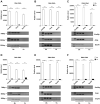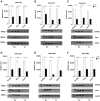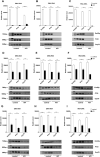In vitro PCR verification that lysozyme inhibits nucleic acid replication and transcription
- PMID: 37076576
- PMCID: PMC10115842
- DOI: 10.1038/s41598-023-33228-6
In vitro PCR verification that lysozyme inhibits nucleic acid replication and transcription
Abstract
Lysozyme can kill bacteria by its enzymatic activity or through a mechanism involving its cationic nature, which can facilitate electrostatic interactions with the viral capsid, the negatively charged parts of nucleic acids, and polymerase, so binding to nucleic acids may be another biological function of lysozyme. Here, PCR was used as a research tool to detect the effects of lysozyme on the replication and transcription of nucleic acids after treatment in different ways. We found that lysozyme and its hydrolysate can enter cells and inhibit PCR to varying degrees in vitro, and degraded lysozyme inhibited nucleic acid replication more effectively than intact lysozyme. The inhibition of lysozyme may be related to polymerase binding, and the sensitivity of different polymerases to lysozyme is inconsistent. Our findings provide a theoretical basis for further explaining the pharmacological effects of lysozyme, such as antibacterial, antiviral, anticancer, and immune regulatory activities, and directions for the development of new pharmacological effects of lysozyme and its metabolites.
© 2023. The Author(s).
Conflict of interest statement
The authors declare no competing interests.
Figures








Similar articles
-
Lysozyme: A Natural Product with Multiple and Useful Antiviral Properties.Molecules. 2024 Jan 30;29(3):652. doi: 10.3390/molecules29030652. Molecules. 2024. PMID: 38338396 Free PMC article. Review.
-
Mechanism of inhibition of bacteriophage T7 RNA polymerase by T7 lysozyme.J Mol Biol. 1997 May 30;269(1):10-27. doi: 10.1006/jmbi.1997.1016. J Mol Biol. 1997. PMID: 9192997
-
Lysozyme association with nucleic acids.Biochem Biophys Res Commun. 1999 Dec 20;266(2):366-70. doi: 10.1006/bbrc.1999.1804. Biochem Biophys Res Commun. 1999. PMID: 10600509
-
Stimulation of lysozyme release by selected microbial preparations.Pharmazie. 2012 Jun;67(6):564-6. Pharmazie. 2012. PMID: 22822548
-
Broad-spectrum and virus-specific nucleic acid-based antivirals against influenza.Front Biosci (Schol Ed). 2010 Jan 1;2(2):791-800. doi: 10.2741/s102. Front Biosci (Schol Ed). 2010. PMID: 20036985 Review.
Cited by
-
Biofilm-disrupting effects of phage endolysins LysAm24, LysAp22, LysECD7, and LysSi3: breakdown the matrix.World J Microbiol Biotechnol. 2024 Apr 29;40(6):186. doi: 10.1007/s11274-024-03999-9. World J Microbiol Biotechnol. 2024. PMID: 38683213
-
Lysozyme: A Natural Product with Multiple and Useful Antiviral Properties.Molecules. 2024 Jan 30;29(3):652. doi: 10.3390/molecules29030652. Molecules. 2024. PMID: 38338396 Free PMC article. Review.
-
EGCG-LYS Fibrils-Mediated CircMAP2K2 Silencing Decreases the Proliferation and Metastasis Ability of Gastric Cancer Cells in Vitro and in Vivo.Adv Sci (Weinh). 2023 Nov;10(32):e2304075. doi: 10.1002/advs.202304075. Epub 2023 Sep 26. Adv Sci (Weinh). 2023. PMID: 37752765 Free PMC article.
References
Publication types
MeSH terms
Substances
LinkOut - more resources
Full Text Sources

